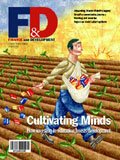 About F&D Subscribe Back Issues Write Us Copyright Information Free Email Notification Receive emails when we post new
items of interest to you. |
Children everywhere are spending more years in school than ever before but positive global trends in educational participation mask large disparities between the world´s richest and poorest countries. Despite improvements in school enrollment, school life expectancy, and gender parity, overall progress has been mixed. In fact, the international community has a long way to go to achieve its 2015 Education for All and Millennium Development Goals for education, in particular, to attain universal primary education and promote gender equality at the primary and secondary levels. Here, we look at progress made and the factors that affect the quality of primary education.
Prepared by the UNESCO Institute for Statistics (UIS),Montreal, Canada. For additional education data, see the UIS website at www.uis.unesco.org. Unless otherwise indicated, the source for all charts is the UIS. |